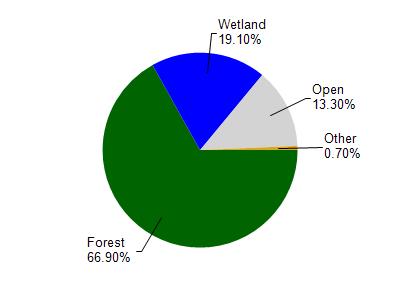Vilas
No
No
Yes
Fish and Aquatic Life
Overview
Ballard Lake, in the Manitowish River Watershed, is a 502.58 acre lake that falls in Vilas County. This lake is managed for fishing and swimming and is currently considered impaired.
Date 2011
Author Aquatic Biologist
Historical Description
Source: 1963, Surface Water Resources of Vilas County Ballard Lake, T-41-N, R-8-E, Section 3, 4, 9, and 10, Area = 505 Surface Acres, Maximum Depth = 25 feet A moderately fertile, alkaline drainage lake with clear water of low transparency, Ballard Lake is known as a muskellunge-walleye lake. Bottom materials are composed of sand and gravel. Muskellunge and walleyes are abundant and wild ducks use the lake for nesting and for feeding during, their spring and fall migration. Public access is available through a town landing and also by navigating the inlet or outlet. There is one resort and W.C.D. canoe camp sites are designated for canoeists who use this lake. There are 13 cottages on the shore line. Aesthetic values are excellent; wilderness values being largely retained by the extensive amount of state-owned frontage.
Date 1963
Author Surface Water Inventory Of Wisconsin
Condition
Wisconsin has over 84,000 miles of streams, 15,000 lakes and milllions of acres of wetlands. Assessing the condition of this vast amount of water is challenging. The state's water monitoring program uses a media-based, cross-program approach to analyze water condition. An updated monitoring strategy (2015-2020) is now available. Compliance with Clean Water Act fishable, swimmable standards are located in the Executive Summary of Water Condition in 2018. See also the 'monitoring and projects' tab.
Reports
Recommendations
Management Goals
Wisconsin's Water Quality Standards provide qualitative and quantitative goals for waters that are protective of Fishable, Swimmable conditions [Learn more]. Waters that do not meet water quality standards are considered impaired and restoration actions are planned and carried out until the water is once again fishable and swimmable
Management goals can include creation or implementation of a Total Maximum Daily Load analysis, a Nine Key Element Plan, or other restoration work, education and outreach and more. If specific recommendations exist for this water, they will be displayed below online.
Monitoring
Monitoring the condition of a river, stream, or lake includes gathering physical, chemical, biological, and habitat data. Comprehensive studies often gather all these parameters in great detail, while lighter assessment events will involve sampling physical, chemical and biological data such as macroinvertebrates. Aquatic macroinvertebrates and fish communities integrate watershed or catchment condition, providing great insight into overall ecosystem health. Chemical and habitat parameters tell researchers more about human induced problems including contaminated runoff, point source dischargers, or habitat issues that foster or limit the potential of aquatic communities to thrive in a given area. Wisconsin's Water Monitoring Strategy was recenty updated.
Grants and Management Projects
Monitoring Projects
| WBIC | Official Waterbody Name | Station ID | Station Name | Earliest Fieldwork Date | Latest Fieldwork Date | View Station | View Data |
|---|
| 2340700 | Ballard Lake | 643224 | Ballard Lake - Deep Hole | 7/10/1984 | 7/28/2020 | Map | Data |
| 2340700 | Ballard Lake | 10020337 | Ballard Lake -- Landing | 5/27/2007 | 9/16/2025 | Map | Data |
| 2340700 | Ballard Lake | 10014835 | Ballard Lake 2001 Comp Survey | | | Map | Data |
| 2340700 | Ballard Lake | 10049055 | Ballard Lake - Musky Alley Deep Hole | 8/24/2017 | 10/3/2025 | Map | Data |
| 2340700 | Ballard Lake | 10005999 | Ballard Lake | 8/29/2000 | 5/31/2025 | Map | Data |
|

Watershed Characteristics
Ballard Lake is located in the Manitowish River watershed which is 268.60 mi². Land use in the watershed is primarily forest (66.90%), wetland (19.10%) and a mix of open (13.30%) and other uses (0.70%). This watershed has 212.08 stream miles, 22,943.16 lake acres and 33,727.48 wetland acres.
Nonpoint Source Characteristics
This watershed is ranked Low for runoff impacts on streams, Low for runoff impacts on lakes and Low for runoff impacts on groundwater and therefore has an overall rank of Low. This value can be used in ranking the watershed or individual waterbodies for grant funding under state and county programs.However, all waters are affected by diffuse pollutant sources regardless of initial water quality. Applications for specific runoff projects under state or county grant programs may be pursued. For more information, go to surface water program grants.